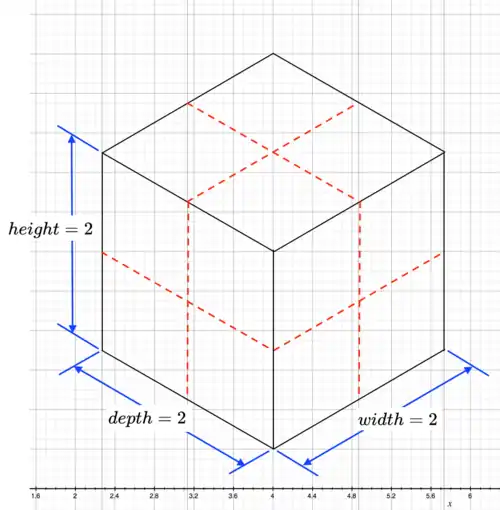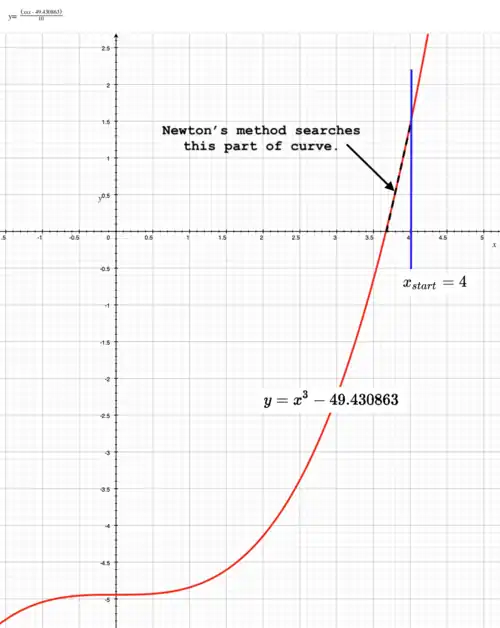Cube root
Introduction

Diagram of cube (in solid black lines.)
The diagram shows the relationship of width, depth or height to surface area and volume. A cube is a regular solid in three dimensions with depth, width and height all equal. In the diagram the figure defined by solid black lines is a cube. Width = depth = height = 2. The length of one side is 2 units. The surface area of one side or or or square units. There are 4 square units in each side. The volume of the cube cubic units. In this case you can see that 8 cubes of 1 unit each, when properly stacked together, form a cube with length of each side equal to 2 units and volume equal to 8 cubic units. In mathematical terms We can say that raised to the power of 3. Usually we say that cubed.
read as raised to the power Usually we say that or cube root of In this case
|
Calculation
Preparation
|
It is desired to calculate the cube root of real number
where:
# python code.
import decimal
dD = decimal.Decimal
dgt = decimal.getcontext()
desired_precision = 100 # Adjust as necessary.
Precision = dgt.prec = desired_precision + 3
NormalizeNumberDebug = 0
def NormalizeNumber (number, flag = 0) :
'''
sign, newNumber, exponent = NormalizeNumber (number [, flag])
sign & exponent are both ints.
newNumber is Decimal object.
1000 > newNumber >= 1 and
exponent % 3 = 0.
This prepares number for cube root of number.
eg, 1234.56e-2 becomes 123456e-4, 12345600e-6, 12.345600e0, 12.3456e0
123.456e7 becomes 123456e4, 1234560e3, 1.234560e9, 1.23456e9
'''
thisName = 'NormalizeNumber () :'
if NormalizeNumberDebug : flag_ = NormalizeNumberDebug
else : flag_ = flag
print_ = flag_ & 1 ; print_all = flag_ & 2 ; check = flag_ & 4
if print_all : print_ = 1
if print_ : check = 4
number = dD(str(number))
if print_ :
print()
print(thisName)
print(' Input number =',number)
if print_all :
print(' flag_ =', bin(flag_))
if number == 0 : return (0, dD(0), 0)
sign, digits, exponent = tuple(number.as_tuple())
if print_all :
print (' ', digits)
print (' exponent =', exponent)
digits = list(digits)
# Remove leading zeroes.
while (digits[0] == 0) :
digits[:1] = []
if print_all :
print (' ', digits)
print (' exponent =', exponent)
# Remove trailing zeroes.
while (digits[-1] == 0) :
digits[-1:] = [] ; exponent += 1
if print_all :
print (' ', digits)
print (' exponent =', exponent)
# Ensure that exponent is exactly divisible by 3.
while exponent % 3 :
digits += [0] ; exponent -= 1
if print_all :
print (' ', digits)
print (' exponent =', exponent)
number_of_digits = len(digits)
if number_of_digits <= 3:
newNumber = dD ( (0,digits,0) )
else :
number_of_integers = number_of_digits % 3
if number_of_integers == 0 : number_of_integers = 3
number_of_decimal_places = number_of_digits - number_of_integers
digits[-number_of_decimal_places:-number_of_decimal_places] = ['.']
exponent += number_of_decimal_places
if print_all :
print (' ', digits)
print (' exponent =', exponent)
while (digits[-1] == 0) :
del(digits[-1])
if print_all :
print (' ', digits)
print (' exponent =', exponent)
newNumber = dD( ''.join([ str(v) for v in digits ]) )
# If necessary, check.
if check :
str1 = str(newNumber)
dD1 = dD( ('', '-')[sign] + str1 + 'e' + str(exponent) )
if dD1 != number :
# This should not happen.
print (thisName)
print (' error:', dD1 , '!=', number)
return None
if print_ :
print (thisName)
print (' Output:')
print (' sign =', sign)
print (' newNumber =', newNumber)
print (' exponent =', exponent)
return sign, newNumber, exponent
|
Example
|
This example illustrates how number # python code.
NormalizeNumber ('00123345.6789000000000000', 2)
NormalizeNumber () :
Input number = 123345.6789000000000000
flag_ = 0b10
(1, 2, 3, 3, 4, 5, 6, 7, 8, 9, 0, 0, 0, 0, 0, 0, 0, 0, 0, 0, 0, 0)
exponent = -16
[1, 2, 3, 3, 4, 5, 6, 7, 8, 9, 0, 0, 0, 0, 0, 0, 0, 0, 0, 0, 0]
exponent = -15
[1, 2, 3, 3, 4, 5, 6, 7, 8, 9, 0, 0, 0, 0, 0, 0, 0, 0, 0, 0]
exponent = -14
[1, 2, 3, 3, 4, 5, 6, 7, 8, 9, 0, 0, 0, 0, 0, 0, 0, 0, 0]
exponent = -13
[1, 2, 3, 3, 4, 5, 6, 7, 8, 9, 0, 0, 0, 0, 0, 0, 0, 0]
exponent = -12
[1, 2, 3, 3, 4, 5, 6, 7, 8, 9, 0, 0, 0, 0, 0, 0, 0]
exponent = -11
[1, 2, 3, 3, 4, 5, 6, 7, 8, 9, 0, 0, 0, 0, 0, 0]
exponent = -10
[1, 2, 3, 3, 4, 5, 6, 7, 8, 9, 0, 0, 0, 0, 0]
exponent = -9
[1, 2, 3, 3, 4, 5, 6, 7, 8, 9, 0, 0, 0, 0]
exponent = -8
[1, 2, 3, 3, 4, 5, 6, 7, 8, 9, 0, 0, 0]
exponent = -7
[1, 2, 3, 3, 4, 5, 6, 7, 8, 9, 0, 0]
exponent = -6
[1, 2, 3, 3, 4, 5, 6, 7, 8, 9, 0]
exponent = -5
[1, 2, 3, 3, 4, 5, 6, 7, 8, 9]
exponent = -4
[1, 2, 3, 3, 4, 5, 6, 7, 8, 9, 0]
exponent = -5
[1, 2, 3, 3, 4, 5, 6, 7, 8, 9, 0, 0]
exponent = -6
[1, 2, 3, '.', 3, 4, 5, 6, 7, 8, 9, 0, 0]
exponent = 3
[1, 2, 3, '.', 3, 4, 5, 6, 7, 8, 9, 0]
exponent = 3
[1, 2, 3, '.', 3, 4, 5, 6, 7, 8, 9]
exponent = 3
NormalizeNumber () :
Output:
sign = 0
newNumber = 123.3456789
exponent = 3 |
Implementation
|
If is type Else, Newton's method is used to derive the root starting with # python code.
simpleCubeRootDebug = 0
def simpleCubeRoot (N, flag = 0) :
'''
cube_root = simpleCubeRoot (N [, flag])
'''
thisName = 'simpleCubeRoot () :'
if simpleCubeRootDebug : flag_ = simpleCubeRootDebug
else : flag_ = flag
print_ = flag_ & 1 ; print_all = flag_ & 2 ; check = flag_ & 4
if print_all : print_ = 1
if print_ : check = 4
if print_ :
print()
print (thisName)
print (' Input N =',N)
if print_all :
print (' flag_ =', bin(flag_))
if N == 0 : return dD(0)
if abs(N) == 1 : return dD(str(N)).normalize()
sign1, n, exponent = NormalizeNumber (N, flag)
if print_all :
print (thisName)
print (' sign1 = {}'.format(sign1))
print (' n = {}'.format(n))
print (' exponent = {}'.format(exponent))
if check :
if sign1 not in (0,1) :
print (thisName, 'Internal error 1.')
return None
if (1 <= n < 1000) : pass
else :
print (thisName, 'Internal error 2.')
return None
if exponent % 3 :
print (thisName, 'Internal error 3.')
return None
# Calculate starting value of x:
status = 1
values_of_v_and_v_cubed = [(9, 729), (8, 512), (7, 343), (6, 216),
(5, 125), (4, 64), (3, 27), (2, 8), (1, 1)]
for v,v_cubed in values_of_v_and_v_cubed :
if n >= v_cubed :
status = 0 ; break
if status :
# This should not happen.
print (thisName, 'Internal error 4.')
return None
if n == v_cubed :
x = v # Exact.
else :
# Newton's method:
x = v + 1 ; y = x**3 - n
status = 1 ; values_of_x = []
if print_all :
print (thisName)
end_ = 0
for t in range (1,51) :
if print_all :
if end_ : print ()
print (' x =', x)
print (' y =', y)
end_ = 1
slope = 3*x*x
delta_x = y/slope
x -= delta_x
if x in values_of_x[-1:-5:-1] :
# This value of x has been used previously.
status = 0
break
values_of_x += [x]
y = x*x*x - n
if print_all : print (' count =', t)
if status :
# This should not happen.
print (thisName, 'count expired.')
return None
multiplier1 = (1,-1)[bool(sign1)]
exponent1, remainder = divmod (exponent, 3)
multiplier2 = 10**dD(exponent1)
root3 = (multiplier1 * x * multiplier2).normalize() # The cube root.
if check :
dgt.prec = desired_precision
n1 = root3 ** 3
dgt.prec = Precision
if (n1 != dD(str(N))) :
print (thisName, 'Internal error 5.')
print (' N =', N)
print (' n1 =', n1)
return None
if print_ :
print (thisName)
print (' Output = N ** (1/3) =', root3 )
return root3
|
Examples
(-49.430863)^(⅓)

Graph of cubic function used to calculate cube root of
axis compressed for clarity. Method calculates therefore and negative sign is preserved. Newton's method quickly finds result: # python code.
NormalizeNumberDebug = 8
N = -49.430863
r = simpleCubeRoot (N, 2)
print ('\nCube root of {} = {}'.format(N,r))
simpleCubeRoot () :
Input N = -49.430863
flag_ = 0b10
simpleCubeRoot () :
sign1 = 1
n = 49.430863
exponent = 0
simpleCubeRoot () :
x = 4
y = 14.569137
x = 3.6964763125
y = 1.077556932370513542983642578125
x = 3.670189185975939771448945836039493832417954712178864798200343445074621595436673614052572376229354069071
y = 0.00764477504335853140747839082789084303615917679270634421640530090118268716447856580204634509997849803
x = 3.670000009751736682821587362098730324894353971034852020032605567239509057372246925097634126721776189698
y = 3.9403549966877805031675033177310279758144394720652549872722882467517684885827998893960547929841E-7
x = 3.670000000000000025911816892145655551872936964331495318518061888183507160413379366174501446719474401728
y = 1.04701101161586186758022322575610863475276107519253768435609331357966880617783675518439E-15
x = 3.670000000000000000000000000000000182948843229450935510129377172924076310714715139745670785290354823955
y = 7.39235902371945511587714470461319164277193070156347301951569000635639E-33
x = 3.670000000000000000000000000000000000000000000000000000000000000000009119967095093791663852670429064766
y = 3.6850777442132631162379569822609127E-67
x = 3.670000000000000000000000000000000000000000000000000000000000000000000000000000000000000000000000000000
y = 0E-101
count = 8
simpleCubeRoot () :
Output = N ** (1/3) = -3.67
Cube root of -49.430863 = -3.67 |
N small
# python code.
N = (dD('654.12345')**3)* dD('1e-234')
r = simpleCubeRoot (N, 2)
print ('\nCube root of',N,'=',r)
simpleCubeRoot () :
Input N = 2.79884698523170070963625E-226
flag_ = 0b10
simpleCubeRoot () :
sign1 = 0
n = 279.884698523170070963625
exponent = -228
simpleCubeRoot () :
x = 7
y = 63.115301476829929036375
x = 6.570644207640612727643707482993197278911564625850340136054421768707482993197278911564625850340136054422
y = 3.7921241319748044856346690723358910662200347438658510815125764506555202024351783380759402655041377003
x = 6.541365939235037323691695638525121571862836044524137388147811941164515617543727416575923849380448976852
y = 0.0168723059341306128289220155501386417560252058196372910481381594756277968737806202081810180585981468
x = 6.541234502641062578339783186964860309131529958383953551860723864105607355316972754950658566210572503873
y = 3.390153665112801204924990755018923043331713010875531529597912358746623245660302509054057497205E-7
x = 6.541234500000000001066344822059465818454480153206314150749531142856041068525641678563938956757562592024
y = 1.368794830901676242840644465509188865946206745677321533271630194477320979479731975131E-16
x = 6.541234500000000000000000000000000000173834354896317173607861575067843889032458069846902551041303696479
y = 2.23139421219918741184735707270203562908734282972217340770547002443E-35
x = 6.541234500000000000000000000000000000000000000000000000000000000000000000004619675833700618822003921149
y = 5.929965871075583921456016257E-73
x = 6.541234500000000000000000000000000000000000000000000000000000000000000000000000000000000000000000000000
y = 0E-100
count = 8
simpleCubeRoot () :
Output = N ** (1/3) = 6.5412345E-76
Cube root of 2.79884698523170070963625E-226 = 6.5412345E-76 |
N with 102 decimal digits
# python code.
desired_precision = 110
Precision = dgt.prec = desired_precision + 3 # Adjust as necessary.
N = dD('91234567890.12345678901234567890123')**3
r = simpleCubeRoot (N,2)
print ('''
Cube root of {}
= {}'''.format(N,r))
simpleCubeRoot () :
Input N = 759413404032709802223035921205529.781633123988862756497856617560063741408069807576943069432557725290867
flag_ = 0b10
simpleCubeRoot () :
sign1 = 0
n = 759.413404032709802223035921205529781633123988862756497856617560063741408069807576943069432557725290867
exponent = 30
simpleCubeRoot () :
x = 10
y = 240.586595967290197776964078794470218366876011137243502143382439936258591930192423056930567442274709133
x = 9.1980446801090326740767864040184326054437466295425216595220585335458046935660252564768981085257509695566666666667
y = 18.77820665551422495383824857173248095793272325233656814694510850270967196003505739741920782438368016883367944227
x = 9.1240599949931623321664263546967588277013422167312019450898763745034405805394622722445816188927044087634255868627
y = 0.15063796707487503447652546220546007622895104520340178579594123893590883076604801830026422013014041937608940920
x = 9.1234568288903645757636608593967193590532344706953269357275443939995698575917750346229607570213472584647914653782
y = 0.00000995803550427983012306112778540777688652481208248640053261156681610990067746729397462608294518324636155989
x = 9.1234567890123458532053846994321774021465971937678169135851020569774194125848355752830106295283475121571096686441
y = 4.352590615034382352966739799800228929244369059424641507909334544190744465475094678843434802753864E-14
x = 9.1234567890123456789012345678901263300904970218124391473359075160634634033723697405398374188771027302554310464010
y = 8.3156486139967105310855857875110175852544229130768260284187973010829718068550033E-31
x = 9.1234567890123456789012345678901230000000000000000000000000000000012154935322004708306387167486681445055079073469
y = 3.0352379658763986320970141849733835293969476411E-64
x = 9.1234567890123456789012345678901230000000000000000000000000000000000000000000000000000000000000000000000000000000
y = 0E-110
count = 8
simpleCubeRoot () :
Output = N ** (1/3) = 91234567890.12345678901234567890123
Cube root of 759413404032709802223035921205529.781633123988862756497856617560063741408069807576943069432557725290867
= 91234567890.12345678901234567890123
recommended that the function be invoked with |
Links to related topics
|
Square Roots using Newton’s Method Roots |